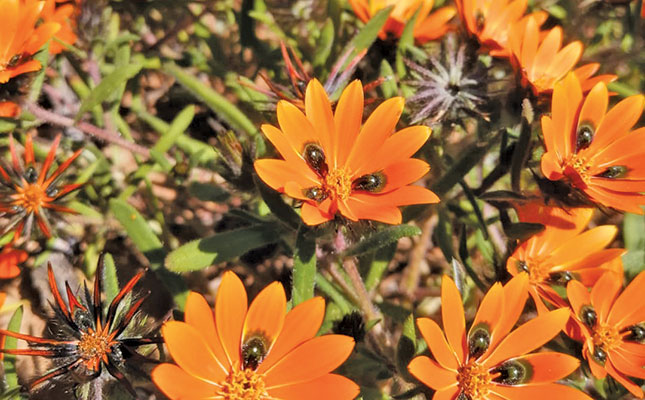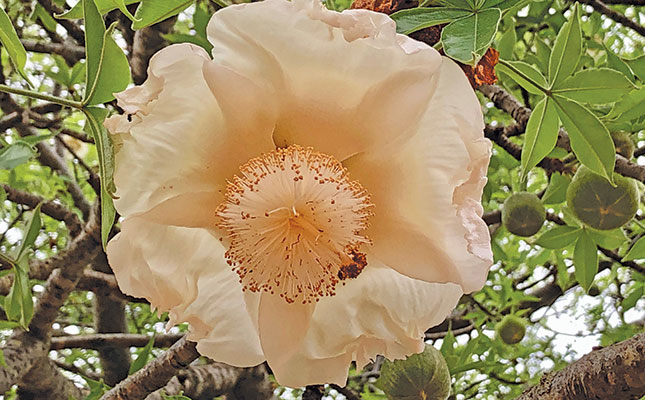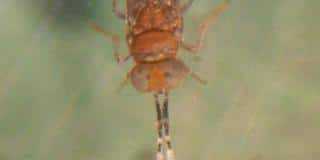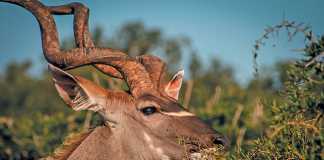
Photo: Louis Kluge
South Africa’s diverse landscapes are home to a unique and astounding variety of fauna and flora. “South Africa is the hub for the world’s flora. Across the globe, South African plant species are planted in gardens and used as cut flowers,” says Leon Kluge, an award-winning South African landscape and garden designer.
Speaking at a South African National Parks Honorary Rangers online seminar in April, Kluge pointed out that plants and animals are closely linked.
“Fauna and flora are interconnected: the one needs the other to survive. People need to be introduced to plants and made aware of this relationship.
“Communities, especially those in the agriculture sector, need to know more about plants before they can understand and fall in love with them.”
Know your pollinators
The diversity of pollinators found in nature ensures that pollination services are provided to a wide variety of plants. Insects normally visit several different plants in a single afternoon, and they collect pollen and nectar from each. As they travel from plant to plant, they deposit pollen from the male reproductive organs of some plants onto the female reproductive organs of others, allowing for fertilisation.
Insect pollination, or entomophily, includes that performed by bees, moths, flies, wasps, beetles, ants and butterflies. Pollination is also conducted by mammals such as bats, monkeys, bushbabies, rodents and squirrels. Birds such as sunbirds are also well-known pollinators.
Honeybees are important pollinators. For thousands of years, humans have kept them to harvest their honey and assist with the pollination of certain crops. Without the pollination services provided by honeybees, farmers wouldn’t realise the yields they have grown accustomed to, some pollinator-dependent crops would fail altogether, and certain sectors of the agriculture sector would struggle to exist.
Flies are also regular pollinators of flowers, visiting them to forage for nectar and pollen, lay eggs, or feed on other smaller insects that may be visiting the plant. Flies are important pollinators of crops such as mango, avocado, carrots and cacao.
Wasps inadvertently carry pollen from flower to flower, whether they are feeding on the pollen itself or, in the case of parasitic wasps, other insects.
Beetles are especially important pollinators in arid areas. Ladybirds can often be found in search of prey on agricultural crops such as peas, sunflowers and tomatoes, and on flowers such as marigolds, orchids and roses. Leaf beetles are often seen on Acacia trees and play an important role in pollinating their flowers.
Moths are largely active at night, and because colours are not clearly distinguishable in the dark, they are attracted by scent more than anything else. Certain flowers have strong fragrances that are often only released at night.
The large-flowered campion (Silene undulata) is a perennial herb that can grow up to 1,2m tall. Between October and April, it bears white to pale-pink flowers that open at dusk, releasing a specific scent to which moths are attracted. Various African orchids are also pollinated only at night by moths.
Butterflies, which are active during the day, are often attracted to red flowers. Since they must land to feed, they prefer large, flat flowers.
Ants visit flowers for their nectar or for the opportunity to prey on other insects. In some harsh and arid areas, plants such as succulents rely on ants for pollination.
Rodents pollinate many Protea species. Field studies show that the flowers of the Whiteheadia bifolia of the family Hyacinthaceae, a plant occurring in the arid winter rainfall areas of southern Namibia, Namaqualand and the Western Cape, are visited at night by rodents.
Bats are nocturnal, and the flowers they pollinate open in the evening, contain nectar, and have evolved to produce strong fruity scents. Baobab trees (Adansonia spp) produce huge, white flowers containing nectar, which are pollinated mostly by fruit bats and occasionally by bushbabies. The bats also feed on flower parts and insects that may be in the flower. Because bats can fly great distances, they may feed on many trees, carrying pollen from flower to flower and tree to tree.

They also pollinate sausage and mango trees, as well as banana plants. Birds tend to pollinate flowers that are large and colourful, as they are easy to spot against a background of leaves. These flowers have plenty of nectar, often at the bottom of a tube of petals. When the birds brush against the anthers and stigmas while reaching for the nectar, the flowers’ pollen is transferred to their beaks and feathers.
How plants attract pollinators
Plants use a number of methods to entice pollinators, including the production of sweet-smelling fragrances and sugary nectar. And while some plants deliver on their promise of sweet nectar, others employ trick tactics to facilitate pollination.
Colour
Red is a spectacular and eye-catching colour in nature. This is especially true for the Table Mountain beauty or mountain pride butterfly (Aeropetes tulbaghia), which is attracted to red flowers. It is native to Southern Africa, where it occurs in South Africa, Lesotho, Eswatini and Zimbabwe.
One of the butterfly’s favourites is the waterfall gladiolus (Gladiolus cardinalis), a rare South African flower with a vibrant tomato-red colour splashed with cream, which occurs near waterfalls and blooms in late spring.
“The flowers aren’t strong enough for sunbirds to perch on, so they depend on the mountain pride butterfly for pollination,” explains Kluge.
Flowers are able to evolve and change their colours to suit the prevalence of local pollinators. A flower may have a certain colour where bees are the main pollinators, but can change its colour if flies or beetles dominate the community, as these insects have different colour perceptions and preferences.
A change in colour doesn’t occur only because of certain insects. Some flowers change colour after they have been pollinated. Certain environmental conditions such as soil acidity and a response to pH changes in a plant’s cells also have an influence on colour, as is the case with some varieties of morning glory, where flowers start out pink as a bud, turn blue in full bloom, and revert to pink as the flowers wilt.
Flowers also use coloured markings to lure insects. The beetle daisy (Gorteria diffusa) is a small annual herbaceous plant. It has bright-orange flowers with green and black markings that mimic female monkey beetles (Clania glenlyonensis). The male beetles see the ‘females’ on the flowers and try to mate with them. After their unsuccessful attempts at mating, they fly off to other flowers where they are similarly tricked and, in the process, pollinate the flowers.
Shape
Some flowers provide a landing platform for insects or birds. In some cases, the flowers are shaped in such a way that pollinators have no choice but to brush against their anthers and stigmas.
Sweet fragrances
Certain flowers, such as the bucket orchids (Coryanthes spp) attract bees with alluring fragrances. While feeding, the bees may slip and fall into the bucket-shaped flowers. In the process of crawling out, they collect pollen, which is then transferred to another flower in a similar way.
Starry wild jasmine (Jasminum multipartitum) is a climber that attracts pollinators with a very sweet perfume produced by its small flowers. Some irises also produce a sweet vanilla scent to attract insects.
Scent of rotting fruit and meat
A number of plants produce the smell of rotting fruit, which is similar to the scent produced by yeast during the fermentation process. Flies are attracted to this scent, and the plant then traps them inside its flowers. In an attempt to escape, the flies move around inside the flowers, and through this activity pollinates them. When the flowers open the next day, the flies are released.
The African starfish flower or, as it is known in South Africa, the carrion flower (Stapelia spp) is known for its foul-smelling blooms that give off a smell reminiscent of rotting meat. The colouration of the flowers and the hairs on their surfaces mimic decaying animal matter, attracting flies that act as pollinators.
Nectar
Many plants produce a sugary nectar to attract insects such as ants, butterflies and bees, as well as birds. Euphorbia are hardy Southern African succulents that produce nectar to attract their pollinators. The nectar is a valuable food source for ants and other insects.
Sexual trickery
The flowers of the mirror orchid (Ophrys speculum) are shaped like female wasps to attract male wasps, which act as pollinators. Disa atricapilla is another orchid species that employs sexual trickery to entice pollinators. Not only do its flowers look like female wasps, but they also produce molecules that mimic the female wasp’s mating pheromones. When a male tries to mate with the ‘female’, it picks up pollen on its body. As it flies away in search of an actual female wasp, it may be fooled once again by another orchid. When it tries once again to mate with the new ‘flower’, the pollen stuck to its body comes into contact with the flower’s stigma and leaves the orchid pollinated.
Agricultural crops
Honeybees pollinate approximately half of all agricultural crops across South Africa, as many of these crops are not indigenous and the insects that pollinate them in their natural habitats don’t occur here. But that’s not to say that other insects cannot contribute towards effective crop pollination.
Many of the same crops that are dependent on pollinators are also threatened by weeds, insect pests and diseases. As a result, farmers often use pesticides and herbicides to protect their crops; however, crop protection must go hand in hand with pollinator protection.
Maize and sweetcorn, which belong to the grass family, are pollinated by wind. Wind-pollinated flowers tend to have small, dull-coloured petals or, in the case of grasses, no petals at all. They also don’t produce nectar or fragrances, as they don’t need to attract animals or insects for pollination.
In addition, the pollen grains are not sticky, unlike like those of plants pollinated by animals. However, the receiving plants’ stigmas are sticky, and they catch the pollen carried by passing breezes.
In contrast, cotton, soya bean and wheat are mostly self-pollinating. Honeybee pollination is essential for crops such as kiwifruit, passion fruit, rowanberry, watermelon, members of the pumpkin family, almonds, macadamias and Brazil nuts.
Sunflower (Helianthus annus) is pollinated by insects (mostly bees), and farmers will often contract beekeepers who provide a pollination service. Since the flowers have both male and female parts, they can self-pollinate or cross-pollinate.
To prevent self-pollination, avocados have a curious flowering system. Each tree produces thousands of tiny flowers, each of which can change their sex. These changes vary according to the cultivar.
A flower will open in the morning as a female with a stigma, then close at about midday. When it reopens in the afternoon of the next day, it will be a male with pollen. The flowers are pollinated by insects, so growers bring honeybee hives into the orchards for pollination.
Kiwifruit flowers are pollinated by insects, but it is not a straightforward process. Each female flower needs to gather thousands of pollen grains from male flowers on its stigma.
The male and female flowers grow on separate plants. The female flowers also produce pollen to attract insects, but the pollen is sterile. As insects visit the flowers, they collect pollen from male flowers and take it to female flowers. Fruit is only formed by the female flowers.
Macadamia trees carry their flowers on long, narrow racemes emerging from the axils of leaves or from the scars of leaves that have been shed. The flowers develop on mature wood on the inside of the tree. The raceme clusters comprise as many as 500 small flowers, each of which has its own pedicel. The proximal flowers bloom first, and although they don’t have real petals (only four petaloid sepals), they do contain male and female parts.
Pollen is released inside the flower one to two days before it opens, and then again one or two hours before. Flowers remain attractive to insects for about three days. Litchi trees flower for as many as 21 days during spring and produce both male and female flowers on the same panicle.
When the flowering period starts, mature trees produce only male flowers for a week or more, after which they switch to producing female flowers for another week or so. They then switch again to produce a second type of male flower. Successful cross-pollination, mostly by honey bees, determines the fruit yield and quality.
Email Leon Kluge at [email protected].











